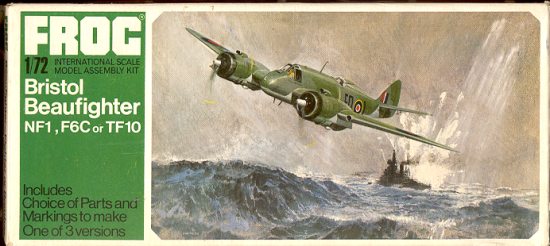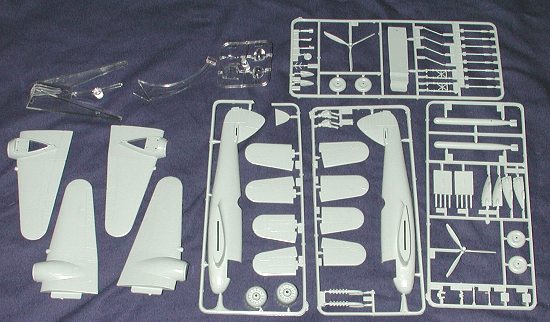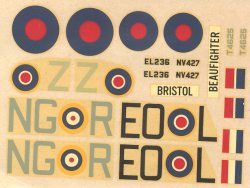
|
KIT: |
Frog 1/72 Bristol Beaufighter I/VI/X |
|
KIT # |
F191 |
|
PRICE: |
$? |
|
DECALS: |
Three aircraft |
|
REVIEWER: |
|
|
NOTES: |
An oldie and it comes with a stand!! |

|
HISTORY |
Planned as a high performance long-ranged fighter, the Beaufighter started taking shape in 1938 as a private venture. The RAF liked what it saw and issued specification F.17/39 the next year to cover the funding of the four prototypes and 300 production aircraft. Shortly after that, the prototype flew on July 17, 1939 and was able to meet all expectations. One reason that it was so quickly built and flown is that it utilized a number of Bleheim features, notably the wings and tail surfaces.
The initial production aircraft was the Mk.I night fighter, which used the highly secret airborne intercept (A.I.) radar that was being developed. It was used successfully during German night raids of 1940-41. Though the Blenheim IF was the first British radar-equipped night fighter, it lacked the speed and fire power of the Beaufighter. The usual armament of the Beaufighter was 4 20mm cannon in the nose and 6 .303 machine guns in the wings.
Later versions were adapted for coastal command work by adding under wing rockets and a fuselage torpedo mount. In these planes, the wing guns were eliminated. Still, they were able to wreak havoc with Axis shipping. The Beaufighter eventually was used by 52 operational RAF squadrons in all theaters of operation. It was especially deadly in the Far East where the Japanese called it the 'whispering death'. The type was also put into use by the RAAF who obtained a license to build it. Though not to enter the war until the last year or so, the Aussie Mk.21 was quite effective in the jungle islands of the southwest Pacific.
|
THE KIT |

You know, it wasn't that long ago when model making was simple. There weren't any aftermarket items, there was no resin or photoetch. Kits cost a buck or two and often a lot less. If you wanted to make a different version from what was kitted, you carved the bits from balsa or used scrap plastic. If you needed different decals, you scrounged your spares bin for what you needed. If you were really lucky, you could find one of the new aftermarket decal sheets from Microscale, ABT or Stoppel to help you out.
Of course, along with all that simplicity was a definite lack of detail, dodgy outlines, rivets, and generally poor fitting parts. It was a real breath of fresh air when Frog got going well. Frog had been around for a long time, but really hit its stride in the late 60's and early 70's. From Frog you got interesting kits and often they were able to be made as different versions with different camo and decal schemes. I know that I really got interested in modeling from seeing all the different markings that came in Frog kits.
This particular one isn't one that I ever built. It has options for three different planes in it; a Mk I night fighter, Mk VI fighter bomber and a Mk.X coastal patrol bomber. You get the different bits to make each one. Actually, it is more like you get the different tail planes for the Mk I and mounts for the torpoedo/rockets for the Mk X. You also get an optional rear gunners position for the Mk.X as well.
Plastic is thick and relatively soft with raised panel lines and not many of those. There are no fully enclosed wheel wells, no cockpit detailing and thick clear bits that will hide any interior work anyway. You do get proper 'hedgehog' exhaust, which even Hasegawa somehow managed to forget. This is also one of the few Frog kits not to have separate control surfaces.
Instructions are some of the first 'Euro' instructions with just diagrams for
the construction sequences. There is no interior painting information. Exterior
colors are on the back of the box, which is one of those 'dough-nut' boxes.
Though the camo and decal placement guide is in color, no color information is
given. One really nice thing about Frog kits is that they have
 great box art and small box art
ads are all around the edges and inside the lip of the box so that we could plan
what to spend our money on next time!
great box art and small box art
ads are all around the edges and inside the lip of the box so that we could plan
what to spend our money on next time!
Decals are for three aircraft. One is a Mk I night fighter from 604 Squadron in 1940-41. It is in overall black. Next is a desert camo Mk VI from 227 Sq at Malta in 1942. Finally a coastal command TF.X from 235 squadron in the usual sea colors. Of course, the decals have yellowed quite a bit in the last 30 plus years, but there are several aftermarket sheets for this plane and if you must use the kit decals, a session in the sunlight should bleach out much of that yellow.
|
CONCLUSIONS |
It certainly isn't a kit that a thoroughly modern modeler would even glance at, except perhaps to sneer a bit at it. However, it is one that kids will have little trouble with and if you feel like a kid or want to relive a bit of your past, well, we won't mind if you go ahead and start building it. ;o)
|
REFERENCES |
Aircraft of the RAF since 1918, Owen Thetford, 1979
If you would like your product reviewed fairly and quickly by a site that has well over 150,000 visitors a month, please contact me or see other details in the Note to Contributors.